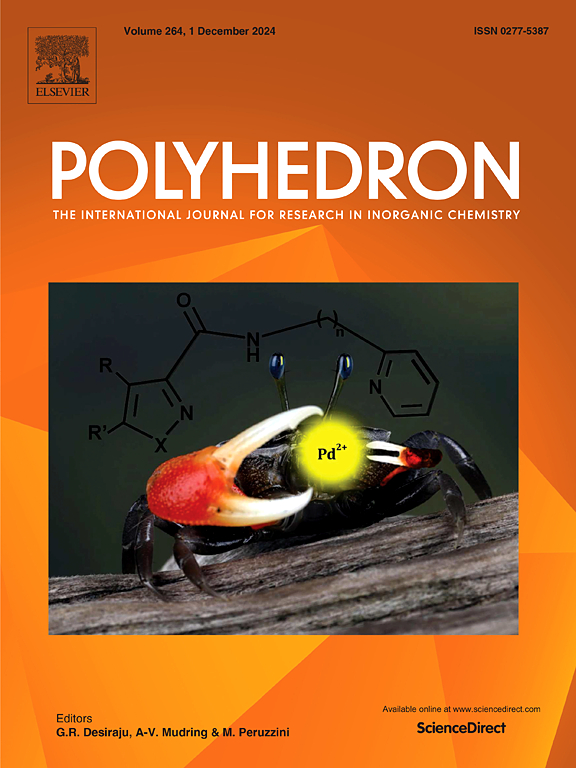Cu, Cl,半坐标键柔韧性;两种铜二聚体及其溶剂化物的合成、理论和晶体学研究
IF 2.4
3区 化学
Q2 CHEMISTRY, INORGANIC & NUCLEAR
引用次数: 0
摘要
合成了两个新的铜二聚体[Cu(L)(μ-Cl)]2,(1 - 2),其中L = 2(RS)C6H4N=NC(COCH3)-SC6H5, R为C6H5(1)或CH3(2)。配合物1和2为五配位体,具有畸变的方锥体结构,由铜(II)离子与SNS配体沿子午方向配位支撑。配合物1结晶为无水二聚体(1)和水合物(1·H2O)。配合物2结晶为纯2相和两种溶剂化物,第一种溶剂为二氯甲烷(2. dcm),第二种溶剂为乙腈(2. acn)。所有五相的晶体结构都已确定。通过晶体学和理论计算证明了Cu⋯Cl半坐标键的灵活性。这些相互作用用分子原子量子理论(QTAIM)进行了分析。数据分析表明,Cu⋯Cl键易于拉伸;Cu⋯Cl半坐标键的距离在1相之间和2相之间变化显著。在1·H2O的情况下,水分子就像分子钳子一样,氢键相互作用将铜离子推得更近。这导致1·H2O中的Cu⋯Cl键较短,比1中的短0.05 Å。因此,Cu-S键距离延长了0.03 Å。此外,与非水合配合物1相比,在1·H2O中S1-Cu1-S2的角度更接近于线性排列,这是由于两个铜中心的靠近。对于2的三个相,Cu⋯Cl的半坐标变化范围为0071 Å。此外,使用各种技术对这两种二聚体进行了分析,包括光谱方法(uv -可见,IR),热分析(TGA)和电化学。本文章由计算机程序翻译,如有差异,请以英文原文为准。

Cu⋯Cl semi-coordinate bond flexibility; synthesis, theoretical and crystallographic studies on two copper dimers and their solvates
Two new copper dimers, [Cu(L)(μ-Cl)]2, (1–2) have been synthesized, where L = 2(RS)C6H4N=NC(COCH3)-SC6H5 with R being either C6H5 (1) or CH3 (2). Complexes 1 and 2 are penta-coordinated with a distorted square pyramidal geometry, supported by the Cu(II) ion coordinated to the SNS ligand in a meridional arrangement. Complex 1 is crystallized as an anhydrous dimer (1) and as a hydrate (1·H2O). Complex 2 is crystallized as pure phase 2 and as two solvates, with dichloromethane as solvent in the first (2.DCM) and acetonitrile in the second (2.ACN). The crystal structures of all five phases have been determined. The flexibility of the Cu⋯Cl semi-coordinate bond was demonstrated through the crystallographic and theoretical calculations. These interactions were analyzed using the Quantum Theory of Atoms in Molecules (QTAIM). Data analysis indicated that the Cu⋯Cl bond is easily stretchable; the distances of the Cu⋯Cl semi-coordinate bonds vary significantly between 1 phases, and between 2 phases. In the case of 1·H2O, water molecules acted like molecular pliers, with hydrogen bonding interactions pushing the copper ion closer. This resulted in a shorter Cu⋯Cl bond in 1·H2O, which is 0.05 Å shorter than in 1. Consequently, the Cu-S bond distances were elongated by 0.03 Å. Additionally, the S1-Cu1-S2 angles in 1·H2O are 5° closer to a linear arrangement compared to the non-hydrated complex 1, due to the proximity of the two copper centers. For the three phases of 2, the Cu⋯Cl semi-coordinate variation range is 0071 Å. Furthermore, the two dimers were analyzed using various techniques, including spectroscopic methods (UV–visible, IR), thermal analysis (TGA), and electrochemistry.
求助全文
通过发布文献求助,成功后即可免费获取论文全文。
去求助
来源期刊

Polyhedron
化学-晶体学
CiteScore
4.90
自引率
7.70%
发文量
515
审稿时长
2 months
期刊介绍:
Polyhedron publishes original, fundamental, experimental and theoretical work of the highest quality in all the major areas of inorganic chemistry. This includes synthetic chemistry, coordination chemistry, organometallic chemistry, bioinorganic chemistry, and solid-state and materials chemistry.
Papers should be significant pieces of work, and all new compounds must be appropriately characterized. The inclusion of single-crystal X-ray structural data is strongly encouraged, but papers reporting only the X-ray structure determination of a single compound will usually not be considered. Papers on solid-state or materials chemistry will be expected to have a significant molecular chemistry component (such as the synthesis and characterization of the molecular precursors and/or a systematic study of the use of different precursors or reaction conditions) or demonstrate a cutting-edge application (for example inorganic materials for energy applications). Papers dealing only with stability constants are not considered.
 求助内容:
求助内容: 应助结果提醒方式:
应助结果提醒方式:


